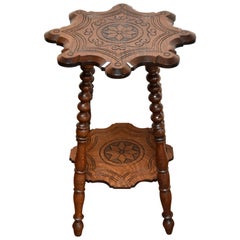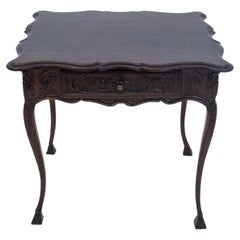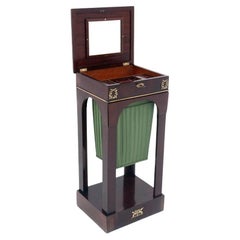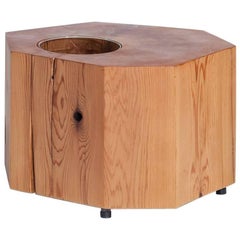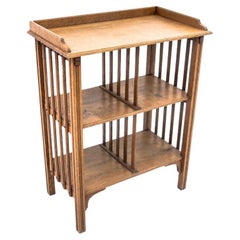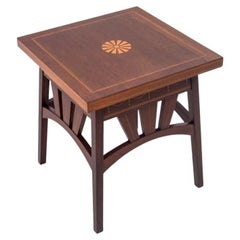Western Side Table
Antique Early 1900s American Classical Side Tables
Oak
Antique Late 19th Century Unknown Neoclassical Side Tables
Walnut
Antique Late 19th Century Unknown Neoclassical Side Tables
Walnut
Antique 1860s French Empire Side Tables
Mahogany
Antique Late 19th Century North American Rustic Side Tables
Wood
2010s Canadian Modern Side Tables
Glass, Cedar
Recent Sales
Vintage 1930s French Side Tables
Oak
Vintage 1920s German Empire Side Tables
Walnut
Antique 1890s Belgian Other Side Tables
Oak
Vintage 1920s Belgian Other Side Tables
Oak
Antique 1890s French Louis Philippe Side Tables
Walnut
Vintage 1910s French Louis XVI Side Tables
Walnut
Antique 1870s German Biedermeier Side Tables
Walnut
Vintage 1920s Belgian Other Side Tables
Oak
Vintage 1910s French Louis XVI Side Tables
Walnut
Antique Early 1900s Swedish Biedermeier Side Tables
Walnut
Antique Early 1900s Belgian Other Side Tables
Walnut
Vintage 1920s French Renaissance Side Tables
Oak
Antique Early 1900s Belgian Renaissance Revival Side Tables
Oak
Antique Late 19th Century Mexican Rustic Side Tables
Iron
Vintage 1920s American Table Lamps
Bronze
Antique 1890s Belgian Louis Philippe Desks and Writing Tables
Oak
Antique Late 19th Century Mexican Rustic Stools
Wood
Vintage 1920s Belgian Side Tables
Oak
Late 20th Century Unknown Romantic Side Tables
Walnut
Early 20th Century American Arts and Crafts End Tables
Ceramic, Wood
Antique Late 19th Century North American Spanish Colonial Stools
Wood
Vintage 1960s American Side Tables
Ceramic
Vintage 1960s American Side Tables
Ceramic
Vintage 1960s Brazilian Side Tables
Vintage 1960s American Side Tables
Ceramic
Vintage 1960s American Side Tables
Ceramic
Vintage 1960s American Side Tables
Ceramic
People Also Browsed
Vintage 1960s Italian Mid-Century Modern Dining Room Chairs
Faux Fur
Vintage 1970s Italian Mid-Century Modern Wall Lights and Sconces
Plastic
21st Century and Contemporary French Modern Side Tables
Carrara Marble, Wrought Iron
21st Century and Contemporary Vietnamese Neoclassical Desks and Writing ...
Wood
Early 20th Century French Folk Art Wall Mirrors
Mirror, Wood
2010s South African Minimalist Pedestals
Wood, Poplar, Burl
Vintage 1940s Danish Scandinavian Modern Lounge Chairs
Beech
20th Century North American Chinoiserie Side Tables
Gold
21st Century and Contemporary American Sofas
Linen, Velvet
Vintage 1970s Italian Mid-Century Modern Beds and Bed Frames
Leather, Wood
Vintage 1960s Swedish Mid-Century Modern Table Lamps
Stoneware
21st Century and Contemporary Asian Mid-Century Modern Night Stands
Leather
Early 20th Century Swedish Gustavian Dining Room Chairs
Bone, Fabric, Bakelite, Birch, Elm
Late 20th Century Organic Modern Lounge Chairs
Fabric, Wicker, Rattan
Antique 19th Century French French Provincial Dining Room Tables
Wood, Hardwood, Walnut
21st Century and Contemporary Indian Chairs
Brass
Western Side Table For Sale on 1stDibs
How Much is a Western Side Table?
Finding the Right Side-tables for You
While the range of styles and variety of materials have broadened over time, the priceless functionality of side tables has held true.
Antique and vintage side tables are an integral accent to our seating and provide additional, necessary storage in our homes. They can be a great foundation for that perfect focal piece of art that you want all your guests to see as you congregate for cocktails in the living room. Side tables are indeed ideal as a stage for your decorative objects or plants in your library or your study, and they are a practical space for the novel or stack of design magazines you keep close to your sofa.
Sure, owning a pair of side tables isn’t as imperative as having a coffee table in the common area, though most of us would struggle without them. Those made of metal, stone or wood are frequently featured in stylish interiors, and if you’re shopping for side tables, there are a couple of things to keep in mind.
With respect to the height of your side tables, a table that is as high as your lounge chair or the arm of your couch is best.
Some folks are understandably fussy about coherence in a living room area, but coherence doesn’t necessarily mean you can’t mix and match. Feel free to introduce minimalist mid-century modern wooden side tables designed by Paul McCobb alongside your contemporary metal coffee table. If you think it isn’t possible to pair a Hollywood Regency–style side table with a contemporary sofa, we’re here to tell you that it is. Even a leggy side table can balance a chunky sofa well. Try to keep a limited color palette in mind if you’re planning on mixing furniture styles and materials, and don’t be afraid to add a piece of abstract art to shake things up.
As far as the objects you’re planning to place on your side tables, if you have heavy items such as stone or sculptures to display, a fragile glass-top table would not be an ideal choice. Think about what material would best support your collectibles and go with that. If it’s a particularly small side table, along with a tall, sleek floor lamp, it can make for a great way to fill a corner of the room you wouldn’t otherwise easily be able to populate.
Whether you are looking for an antique 19th-century carved oak side table or a vintage rattan side table (because rattan never went away!), the collection on 1stDibs has you covered — find Art Deco side tables, bamboo side tables, travertine side tables and more today.
- What are side tables used for?1 Answer1stDibs ExpertApril 5, 2022Side tables are used next to furniture like beds and couches to provide an accessible place for keeping essential items at hand. In the living room, side tables are often used to display flower arrangements, photos or books as well as to set down a drink. In the bedroom, a side table is typically populated with items like a lamp, bedtime reading material, and a charging device for a phone. Shop a collection of vintage and contemporary side tables from some of the world’s top sellers on 1stDibs.
- What are nesting side tables?1 Answer1stDibs ExpertApril 5, 2022A nesting table is a set of tables designed to be stored one inside or under the other, giving them a layered or stacked appearance. A side table is a table that’s placed beside a piece of furniture. A nesting side table would be a series of side tables in graduated heights that can be stacked or nested together. Shop a collection of nesting tables from some of the world’s top sellers on 1stDibs.
- 1stDibs ExpertSeptember 25, 2019
A side table should stand one to three inches below the arm of the sofa or chair it is placed next to.
- What are side tables called?1 Answer1stDibs ExpertNovember 13, 2024Side tables are often simply called side tables. If positioned on either end of a sofa or loveseat, you might refer to them as end tables. General terms for side tables and other tables commonly used in seating areas include occasional tables and accent tables. On 1stDibs, shop a wide range of side tables.
- 1stDibs ExpertMay 5, 2023There are two differences between end tables and side tables: function and size. Typically, end tables go beside a chair or at opposite ends of a sofa and have smaller tabletops, while side tables go toward the sides of seating areas or against walls and feature a larger surface area. However, many people use the words side and end tables interchangeably, so these differences may not always apply. On 1stDibs, shop a variety of end and side tables.
- 1stDibs ExpertOctober 7, 2024The difference between a side table and a coffee table is mainly in the size and shape. Coffee tables usually feature larger tops but shorter legs. People typically place them in front of a sofa or a loveseat to rest books, drinks, remote controls and other items. Side tables also store items, but they are usually positioned beside an accent chair or at the ends of a sofa or loveseat. Shop a diverse assortment of side tables and coffee tables on 1stDibs.
- 1stDibs ExpertMay 5, 2023To determine whether a side table is an antique, closely examine its details. Older pieces will typically have telltale features like wood pegs, hand-cut dovetails with some slight imperfections and mortise-and-tenon construction. Tables that are a consistent color throughout or have machine-cut moldings or carvings are unlikely to be antiques. A certified appraiser or knowledgeable antiques dealer can be a helpful resource when dating tables. Shop a collection of antique, vintage and modern side tables on 1stDibs.
- 1stDibs ExpertSeptember 28, 2021A tall side table may also be called a console table. While these furnishings are not as common in today’s interiors as their coffee-table and side-table counterparts, console tables are stylish home accents and have become more prevalent over the years. The popularity of wood console tables took shape during the 17th and 18th centuries in French and Italian culture, and were exclusively featured in the palatial homes of the upper class. Find console tables today on 1stDibs.
- 1stDibs ExpertSeptember 23, 2024What tiny side tables are called varies. Some people may simply refer to them as side tables. Others describe them as end tables if they're placed on either end of a sofa or loveseat. When used elsewhere in a room, small side tables are often called accent tables. On 1stDibs, explore a large selection of antique, vintage and contemporary side tables.
- 1stDibs ExpertMarch 25, 2024No, a side table shouldn't always be lower than a sofa. To make it easy to access items on a table, a sofa's arms should generally be no more than 2 to 3 inches above or below the tabletop. This rule of thumb differs from the one for coffee tables, which should be as tall or 1 to 2 inches shorter than the seat height of the sofa to ensure a balanced look. Explore a large selection of side tables on 1stDibs.
Read More
20 Inviting Dining Rooms Perfectly Arranged for Entertaining
Top interior designers show — and tell — us how to create delectable spaces for hosting dinner parties.
This Alain Delon–Designed Table Is Almost as Handsome as He Was
Fans of the French film star may be surprised to learn that he had a flair for furniture with sleek lines and disco-era flash.
Uchronia’s Plant Stand Gives Pots a Pretty Perch with All the Trimmings
Like other pieces in the firm’s Candy Box collection, the cheerful limited-edition design showcases French craft.
The Ultimate Guide to Types of Tables for the Home
Whether you’re just moving in or ready to give your home a makeover, our guide will give you pointers on tables that are fitting for every room, nook and hallway.
Is Lionel Jadot the Willy Wonka of Upcycled Belgian Design?
From his massive collaborative workshop in a former paper factory, the designer concocts funky furniture from disused materials, as well as luxe hotel interiors like the new Mix Brussels.
Inspired by the Cosmos, Sandra Nunnerley’s Nova Table Has a Futuristic Feel
The designer’s innovative use of an unexpected material gives this console a lift.
This 19th-Century Gilded Desk Displays a Fanciful Kingdom in Marquetry
The stately piece brings both gravitas and whimsy to any work space.
In Guadalajara, These Luscious Side Tables Are Chiseled from Volcanic Rock
Use them as tables or stools, indoors or out.
